| |
|
|
|
What are the most recent developments regarding environmental matters.?
The major environmental issue remains the threat of global warming which the subject of a separate Newsbatch summary.
Why are environmental issues a major public policy challenge?
In the past three decades there has been a global awakening regarding environmental issues. Considerable progress has been made in addressing a variety of very complex and technical problems associated with a historical disregard of these issues. But environmental issues continue to be some of the most important and perplexing problems facing all governments today.
Part of the difficulty facing politicians and the public is the technical complexity of the subject. A full understanding of the risks is often limited to scientists who specialize in a particular field of knowledge. On some issues there is serious disagreement among scientists which puts lay policy makers in a very difficult dilemma.
The resolution of environmental problems also involves a careful balancing of competing interests and values. Business interests frequently resist attempts at environmental regulation and this resistance usually reflects a public demand for products and development. Some environmental activists oppose many aspects of further human economic development because of threats to the remainder of the ecosystem. Others are chiefly concerned about current and future threats to the health of the human population.
Environmental issues present special difficulties for developing countries. These countries pose the biggest potential threat of exacerbating threats to the environment. But absent massive infusions of assistance from richer countries, they simply cannot afford to match environmental controls being adopted by developed countries.
Newsbatch provides summaries on the following policy issues:
Air Quality
National Lands
Species Preservation
Treatment of Waste
Nuclear Waste
Water Quality
Chemicals in Air and Food
Genetically Modified Foods
Global Population Growth
|
|
Air Quality
We have been concerned about air quality for over a generation. What progress has been made?
Due primarily to increasingly stringent emission standards and cleaner gasolines mandated by a succession of Clean Air Acts, air quality has improved.  (Click to see chart) There has been significant progress in California where emission standards are the most stringent. While motor vehicles continue to be a major source of air polution (Click to see chart) There has been significant progress in California where emission standards are the most stringent. While motor vehicles continue to be a major source of air polution  (Click to see chart), the number of unhealthy days in some major smog-prone cities such as Los Angeles has been reduced significantly. (Click to see chart), the number of unhealthy days in some major smog-prone cities such as Los Angeles has been reduced significantly.  Despite this progress, air pollution remains a health problem and many experts insist that more needs to be done. Basically due to increases in population, more areas of the country are experiencing air pollution problems. Despite this progress, air pollution remains a health problem and many experts insist that more needs to be done. Basically due to increases in population, more areas of the country are experiencing air pollution problems. 
How is the Clean Air Act enforced?
With respect to vehicles, the Clean Air Act has established emission standards which must be met by automobile manufacturers. With respect to stationary sources of pollution, enforcement is divided between the federal government and the states. Under this law, EPA sets limits on how much of a pollutant can be in the air anywhere in the United States. This ensures that all Americans have the same basic health and environmental protections. The law allows individual states to have stronger pollution controls, but states are not allowed to have weaker pollution controls than those set for the whole country. The system requires larger sources of discharge to obtain permits.
What is "acid rain" and how is it being controlled?
Acid rain refers to a type of air pollution that contains chemicals high in acidity. The most common type of acid rain in the United States is caused by pollutants from big coal-burning power plants in the Midwest. These chemicals rise high into the air and are carried by winds toward the East Coast of the U.S. and Canada. When winds blow the acid chemicals into areas where there is wet weather, the acids become part of the rain, snow or fog. In areas where the weather is dry, the acid chemicals may fall to Earth in gases or dusts.
The environmental damage caused by acid rain is significant. Lakes and streams ranging from Michigan's Upper peninsula to Maine have been affected by acid rain. Some types of trees are have been severely damaged. Acid rain is associated with breathing problems, particularly asthma, and it causes property damage as well.
The Clean Air Act of 1990 mandates that in the year 2000, annual releases of sulfur dioxide are to be about 40 percent lower than the 1980 levels. There are stiff penalties for plants which release more pollutants than their allowances cover.
What can be done to further reduce air pollution?
With respect to auto emissions, the rules pertaining to vehicles were applied to small trucks and SUVs in 1999, thus closing a major gap in vehicle emission control. However, in March 2002 the Senate voted to soften these requirements.  But emission standards do not apply to heavy duty trucks and buses. The technology exists for these vehicles to run 90% cleaner than they do today. Many have urged that emission standards be applied to these vehicles and that diesel fuels be made cleaner. But emission standards do not apply to heavy duty trucks and buses. The technology exists for these vehicles to run 90% cleaner than they do today. Many have urged that emission standards be applied to these vehicles and that diesel fuels be made cleaner.
There is also concern that the emission standards on coal burning are not stringent enough. Coal-burning power plants have long been recognized as a major source of air pollution. But environmentalists maintain that the oldest and dirtiest plants have largely escaped clean air standards imposed on newer power plants, largely due to the army of lobbyists for the electric power industry. Legislation has been proposed to impose stricter emission standards on these plants.
Return to Top
Air Quality Links
Google Directory - Air Quality
US EPA Office of Air and Radiation
Smog - Wikipedia, the free encyclopedia
Acid rain - Wikipedia, the free encyclopedia
Air pollution - Wikipedia, the free encyclopedia
|
Charts
(click to enlarge)
Air Emission Trends 1980-2008
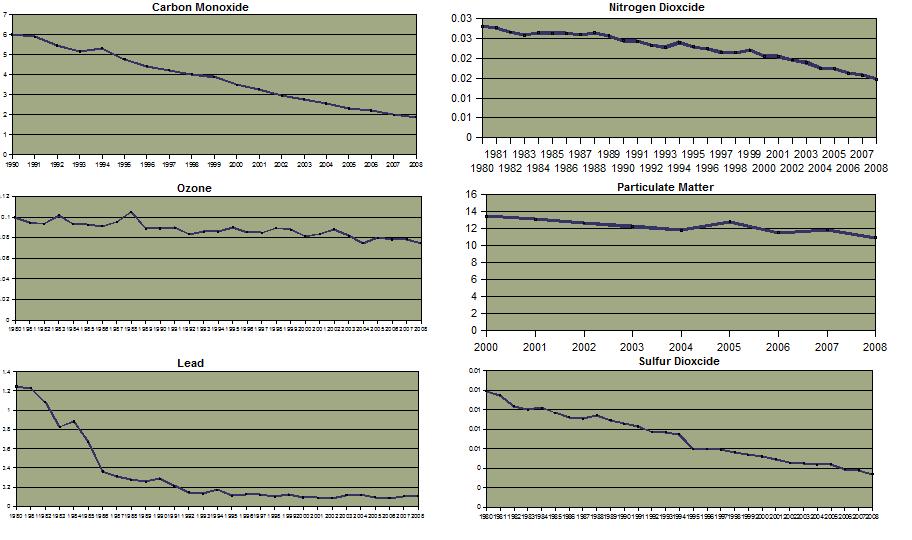
Sources of Air Pollution
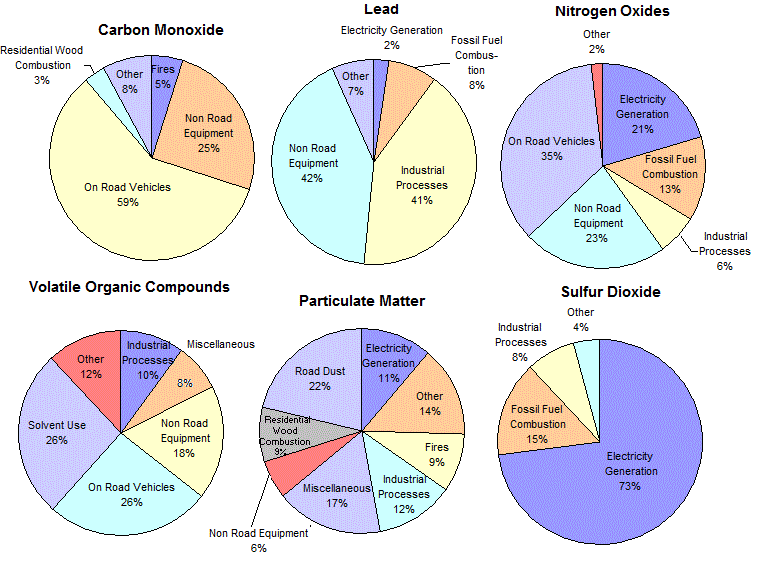
Percentage Change in Unhealthy Days from 1993-1997 and 2005-2007
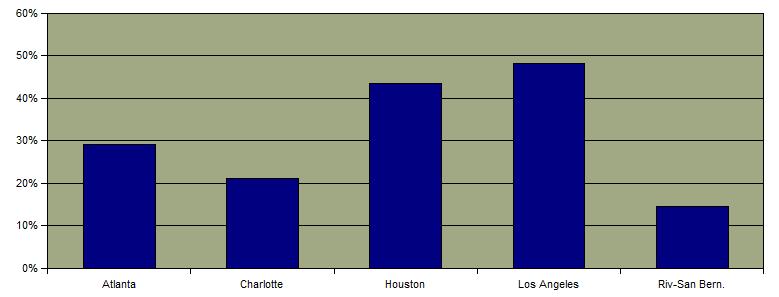
Number of Days With Air Quality Index Over 100 by County, 2000 and 2008

Vote on Less Stringent Emission Controls for Light Trucks and SUVs
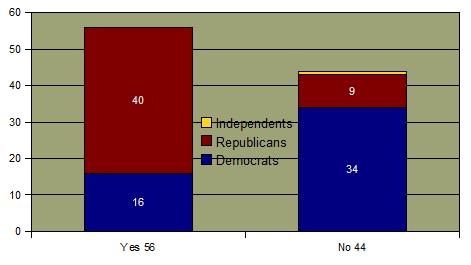
|
|
National Lands
What is the controversy concerning our national lands?
About 650 million acres of land is owned by the federal government.  Much of this land is undeveloped land in western states. For the past several decades there has been an ongoing struggle between protecting lands in their natural state and the desire to convert these lands toward economic benefit is ongoing. For example, the Wilderness Society recently identified 15 locations as America's most endangered wildlands. Much of this land is undeveloped land in western states. For the past several decades there has been an ongoing struggle between protecting lands in their natural state and the desire to convert these lands toward economic benefit is ongoing. For example, the Wilderness Society recently identified 15 locations as America's most endangered wildlands. 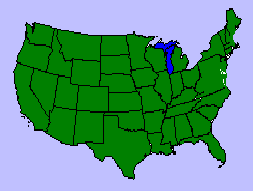 (Click to see map) (Click to see map)
What has been done to protect our natural forests?
Only four percent of original forests remain standing in the United States and 3/4 of them are part of the national forest system. The Clinton Administration had a mixed record in preserving National Forests. In 1995, President Clinton signed legislation which temporarily opened National Forest areas to logging, ostensibly for the purpose of promoting "forest health". Environmental activists maintain that the result of this legislation was an unprecendented intrusion on forest habitats resulting not only in the removal of trees but also the destruction of many associated organisms. The administration subsequently implemented a moratorium on road building in National Forests, which environmentalists believe is an important step toward the protection of these areas.
The most important present issue concerning national lands involves drilling for oil in the Arctic National Wildlife Refuge.  The debate is focused on drilling in a 1.5-million-acre slice in the northeast corner of the 19-million-acre refuge. When Congress set aside the land in 1960, it prohibited development. When President Jimmy Carter expanded the refuge area in 1980, the 1.5-million-acre section was left open to the possibility of oil exploration. Oil developers and their allies in Congress have long pushed to open the area. The Bush Administration's efforts to allow exploration in the area were unsuccessful. The most recent Senate and House votes on the issue occurred in May 2008. See Senate vote See House vote The debate is focused on drilling in a 1.5-million-acre slice in the northeast corner of the 19-million-acre refuge. When Congress set aside the land in 1960, it prohibited development. When President Jimmy Carter expanded the refuge area in 1980, the 1.5-million-acre section was left open to the possibility of oil exploration. Oil developers and their allies in Congress have long pushed to open the area. The Bush Administration's efforts to allow exploration in the area were unsuccessful. The most recent Senate and House votes on the issue occurred in May 2008. See Senate vote See House vote
Are all public wilderness areas part of the National Park and National Forest system?
No. Much of our public wilderness areas are under the supervision of the Bureau of Land Management.
The Bureau of Land Management was formed in 1946 under the Department of the Interior to replace the Grazing Service and the General Land Office. It wasn't until 1976, when Congress passed the Federal Land Policy and Management Act (FLPMA), that the BLM was given its modern-day charge of managing the public lands and their various resources values, "so that they are utilized in the combination that will best meet the present and future needs of the American people."
The BLM controls a total of 264 million acres - as much as the National Parks Service and the US Forest Service combined. This number includes 177 million acres in the lower 48 states and 87 million acres in Alaska. Outside of Alaska, BLM lands are primarily in the western states. These include: Arizona, California, Colorado, Idaho, Nevada, New Mexico, Oregon, Montana, Utah, Washington, Wyoming. Of the 177 million acres in the lower 48 states there are an estimated 60 million acres of unprotected wilderness. 
National Monuments are designated to protect objects of scientific and historic interest by public proclamation by the President (under the Antiquities Act of 1906) or by Congress for historic landmarks, historic, and prehistoric structures, or other objects of historic or scientific interest on public lands. National Conservation Areas (NCAs) are designated by Congress to conserve, protect, enhance, and manage public land areas for the benefit and enjoyment of present and future generations. NCAs feature exceptional natural, recreational, cultural, wildlife, aquatic, archeological, paleontological, historical, educational, and/or scientific resources. National Preserves are areas having characteristics associated with national parks, but in which Congress has permitted continued public hunting, trapping, oil/gas exploration and extraction. Many existing national preserves, without sport hunting, would qualify for national park designation. At present, there are 17 national preserves in the National Park System, 10 of which are located in Alaska.
Environmental organizations are concerned about threats to these lands, many of which are unprotected. The recent energy plan announced by the Bush administration includes the possibility of further oil and gas exploration on these lands. In addition there is concern regarding the growing use of off-road vehicles and the resultant threat to the natural habitat and beauty of these areas.
What about wetlands?
The U.S. has undergone a reversal in policy pertaining to wetlands. Historically, legislation had encouraged the conversion of wetlands into usable agricultural or residential property. But a growing environmental awareness has included the appreciation of the benefits of wetlands. Wetlands protect water quality, buffer coastal areas from erosion, and provide varied aesthetic and recreational opportunities for millions of people. These concerns prompted passage of legislation which now provides some protection. By replacing incentives with disincentives, the rate of wetland loss decreased by 80% from 1986 to 1997.  But environmentalist activists complain that existing legislation do not provide a comprehensive national approach and are concerned that wetlands are insufficiently protected from development. But environmentalist activists complain that existing legislation do not provide a comprehensive national approach and are concerned that wetlands are insufficiently protected from development.
The Clinton Administration took a strong interest in the wetlands debate. In 1993, it announced new federal policies based on five principles: 1) supporting no overall net loss of the Nation's remaining wetlands together with increasing the quality and quantity of wetlands as a long-term goal; 2) making regulatory programs fair, flexible, and predictable; 3) encouraging options to regulatory programs; 4) expanding partnerships to protect and restore wetlands in an ecosystem/watershed context; and 5) basing wetland policies on the best scientific information available. Subsequently, it sought increased funding for wetlands protection efforts through the Clean Water Action Plan and the Lands Legacy Initiative, and set a goal of a net gain of 100,000 acres annually starting in FY2005.
But there has been opposition to these efforts. Large landowners, farmers, small businessmen, and individuals who own small parcels of land, who counter that protection efforts have gone too far, and that wet areas that provide few wetland values have been aggressively protected. They have been especially critical of the U.S. Army Corps of Engineers (Corps) and the U.S. Environmental Protection Agency (EPA) for administering the §404 program in an overzealous and inflexible manner.
What about global land issues? Has progress been made halt the destruction of the rain forests?
Through a massive global educational effort, some progress has been made to halt tropical rainforest destruction, particularly in Brazil. But concern has not diminished and the rate of destruction of these forests does continue. 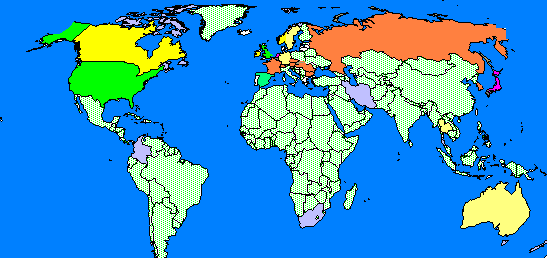 The buildup of greenhouse gases in the atmosphere is being driven in part by deforestation, and global warming threatens to emerge as a major factor that drives forest loss in the next century, leading in turn to even greater emissions. There is a growing recognition that the rate of destruction is occurring more rapidly in the poorest countries and that if the resources of these countries were greater, there would be less destruction as there would be recognition of the long term economic benefits of maintaining these forests.
The buildup of greenhouse gases in the atmosphere is being driven in part by deforestation, and global warming threatens to emerge as a major factor that drives forest loss in the next century, leading in turn to even greater emissions. There is a growing recognition that the rate of destruction is occurring more rapidly in the poorest countries and that if the resources of these countries were greater, there would be less destruction as there would be recognition of the long term economic benefits of maintaining these forests.
In the late 19th century, the United States pioneered the preservation of natural lands by establishing Yellowstone National Park. A growing global environmental awareness has led to a steady increase in the 20th century, particularly in the last three decades.  In many countries, a significant portion of the land is under protection. In many countries, a significant portion of the land is under protection. 
Where do Democrats and Republicans stand on national land issues?
Overall, there has been a clear difference between the two parties on this issue which has been demonstrated by key congressional votes.  The Democratic platform clearly states the party's commitment to the preservation of national lands and parks. The Republican platform also states the Republican commitment to national parks. But it also advocates turning over many land protection decisions to state and local governments and indicates a commitment to provide responsible access to logging companies. A major disagreement during the campaign debates between President Bush and Candidate Gore concerned the desirability of drilling for oil on the Artic Wildlife Preserve. The Democratic platform clearly states the party's commitment to the preservation of national lands and parks. The Republican platform also states the Republican commitment to national parks. But it also advocates turning over many land protection decisions to state and local governments and indicates a commitment to provide responsible access to logging companies. A major disagreement during the campaign debates between President Bush and Candidate Gore concerned the desirability of drilling for oil on the Artic Wildlife Preserve.
Return to Top
Land Issue Links
Google Directory - Forests and Rain Forests
National Park Service - Wikipedia, the free encyclopedia
United States Forest Service - Wikipedia, the free encyclopedia
Bureau of Land Management - Wikipedia, the free encyclopedia
World Wildlife Fund
Worldwide National Park Information Page
The Wilderness Society
Sierra Club
|
Charts
(click to enlarge)
Status of National Lands, 2007
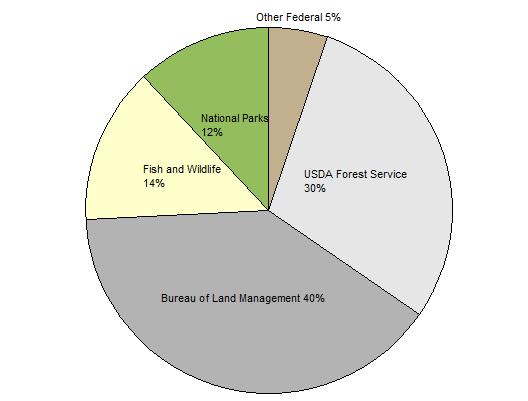
15 Threatened Areas Identified by Wilderness Society
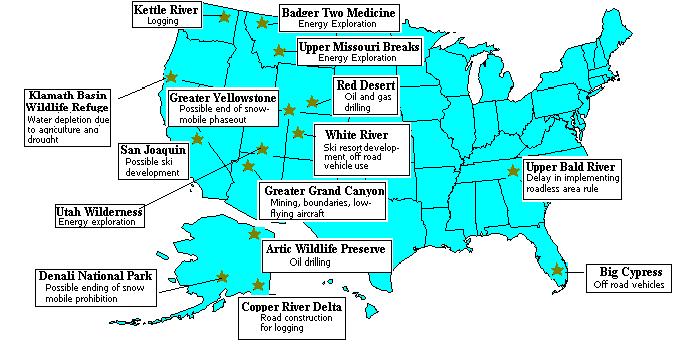
Map of Arctic Wildlife Refuge
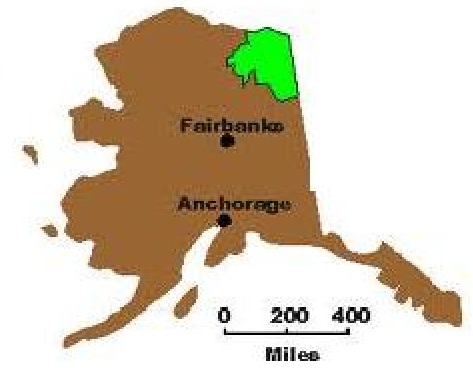
BLM Managed Lands
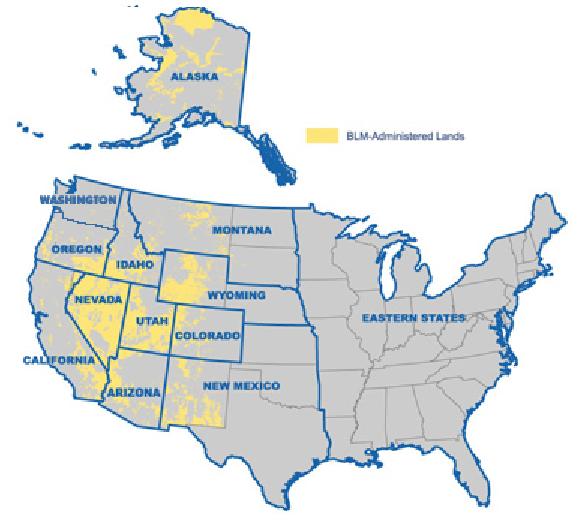
Comparison of Wetland Areas 1986 and 1997
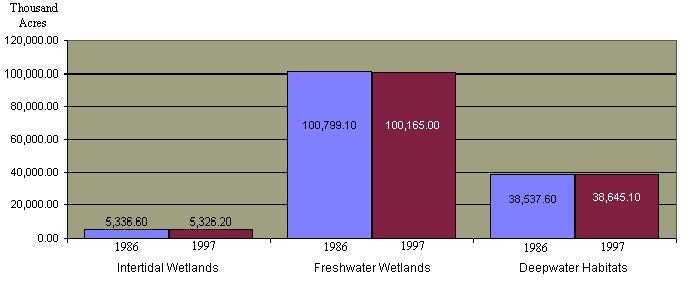
State of World's Forests
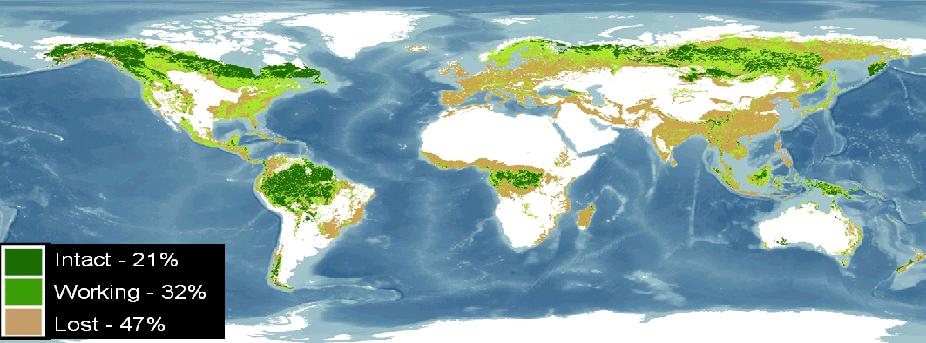
Growth of World's Protected Areas

Status of the World's Protected Areas, 2007
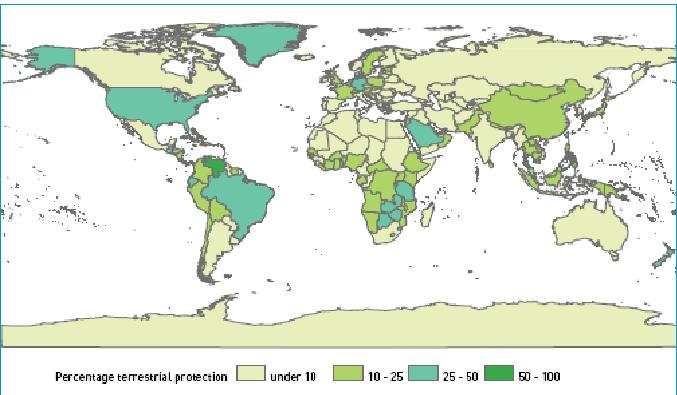
Congressional Voting Records on Conservation in 2008
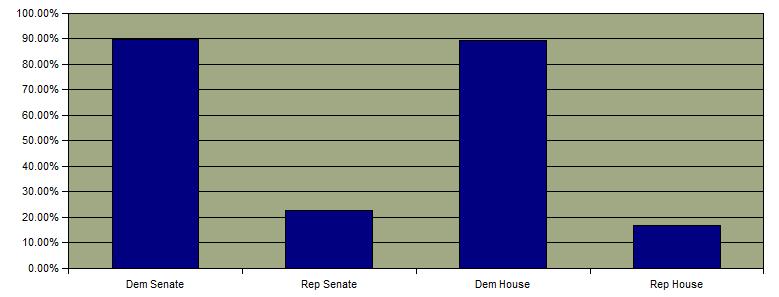
|
|
Species Preservation
What are we doing to protect endangered species?
The Endangered Species Act was enacted without controversy in 1973 with the simple but ambitious goal of reversing the decades of neglect and abuse that have pushed many irreplaceable species of plants and animals to the brink of extinction. Under the provisions of this legislation, plants or animals are classified as "endangered" or "threatened". Endangered species cannot be purchased or sold in interstate or foreign commerce. Endangered animal species cannot be killed, hunted, collected, injured, or otherwise subjected to "harm." The same restrictions apply to plants, except on private land, where the "take" of plants is not prohibited. Protections for threatened plants and animals are more flexible than those for endangered species, but in the case of a particular species may include any and all of the above measures. Despite the protections of this act, the number of plants and animals which are endangered has grown, but not dramatically for mammals and birds. Only 11 species have been de-listed to recovery although many others are under consideration at present.  (Click to see chart) But 41% of the species have increased or stabilized in their populations under the protections of the act. And there have been successes. For example, the bald eagle population increased from a low of 400 nesting pairs in 1963 to just over 4,700 nesting pairs in 1995 within the contiguous United States. The 1972 ban on DDT was a significant factor in this recovery. (Click to see chart) But 41% of the species have increased or stabilized in their populations under the protections of the act. And there have been successes. For example, the bald eagle population increased from a low of 400 nesting pairs in 1963 to just over 4,700 nesting pairs in 1995 within the contiguous United States. The 1972 ban on DDT was a significant factor in this recovery.
What has causes plants and animals to become endangered?
Until recent decades, the focus of the extinction debate was on losses due to over-exploitation, generally through hunting, trapping, or fishing. But the vast majority of species now protected under the ESA reached that status due to habitat loss. Even those species for which direct taking was probably an early factor in their decline are generally also at risk due to habitat loss. Habitats reduced now to a small fraction of their former extent include tall-grass prairie, fresh and salt water wetlands, old growth forests of most types, free-flowing rivers, coral reefs, undisturbed sandy beaches, and others.
Why is the law become controversial?
Landowners fear that the presence of a listed species or the designation of their land as critical habitat will result in loss of some or all of their property rights and a decrease their land values. As a result, critics say that it provides landowners with an incentive landowners to remove habitat to avoid federal intervention which is counterproductive to the purpose of the legislation. The Clinton Administration addressed these concerns by attempting to provide more flexibility in the implementation its provisions. These measures include the negotiation of agreements with landowners who agree to preserve habitat in return for an assurance that there will be no further costs or restrictions on the use of the property, except by mutual consent. In some cases, changes may be carried out provided that the costs are not borne by the landowner. While landowners like the increased certainty, the program has been criticized by conservationists as potentially locking in conservation measures that are inadequate or unable to respond to changing conditions.
Because of the controversy, there has been no specific funding of the Endangered Species Act since 1992 although funds have been authorized for its procedural implementation during each subsequent fiscal year.
During the past Congress, there were two competing measures for modifying and reauthorizing funding for the Endangered Species Act. One proposal was to strengthen the Act by represents a constructive and proactive effort to recover declining species by setting recovery goals and providing financial incentives for landowners. This proposal was generally supported by environmental advocates. A competing measure would have reauthorized the Endangered Species Act, allowed economic injury as grounds for a citizen lawsuit, increased the role of states in listing decisions and placed a deadline on recovery plans. A companion measure would provide compensation to landowners in cases in which the Endangered Species Act and its regulations have an economic impact on private landowners. These measures had substantial support from private property advocates. No legislation was ultimately passed and the controversy thus continues.
What about global efforts to protect endangered plant and wildlife?
The preservation of endangered species is a global concern. Plant and animal species are being particularly threatened in tropical countries, many of which are undergoing a massive change in habitat as their economies modernize and their populations increase. 
For example, many fish stocks are in drastic decline, with three quarters of marine fisheries fully fished, overexploited, depleted, or slowly recovering from collapse. Oversubsidized national fishing fleets are harvesting fish at unsustainable rates, placing both fishery resources and the future of fishing communities at risk. There was a massive increase in fishing capture from the late 1980's through 2000. The average annual production is now just under 100 million tons.  This growing concern has led to a recognition these stocks must be managed jointly if they are to be conserved. This strengthening of international resolve was demonstrated in 1992, when a United Nations resolution banning the use of long drift nets on the high seas was adopted. This ban has been implemented successfully worldwide, with very few exceptions. U.N. Conference on Straddling Stocks and Highly Migratory Fish Stocks agreement, which was formally adopted in December 1995, calls for a conservative approach to fisheries management--dubbed the "precautionary approach"--that errs on the side of protecting fish stocks rather than simply responding to declines once they occur. The agreement requires that special efforts be made to monitor fish stocks, and it strengthens inspection and reporting requirements for boats. A more comprehensive agreement emerged from the Johannesburg summit. The agreement envisages restoring most of the major global fisheries to commercial health by 2015. The significant increase in aquaculture has not only reduced pressure on the marine fisheries but also is a promising solution to the looming world food problem. This growing concern has led to a recognition these stocks must be managed jointly if they are to be conserved. This strengthening of international resolve was demonstrated in 1992, when a United Nations resolution banning the use of long drift nets on the high seas was adopted. This ban has been implemented successfully worldwide, with very few exceptions. U.N. Conference on Straddling Stocks and Highly Migratory Fish Stocks agreement, which was formally adopted in December 1995, calls for a conservative approach to fisheries management--dubbed the "precautionary approach"--that errs on the side of protecting fish stocks rather than simply responding to declines once they occur. The agreement requires that special efforts be made to monitor fish stocks, and it strengthens inspection and reporting requirements for boats. A more comprehensive agreement emerged from the Johannesburg summit. The agreement envisages restoring most of the major global fisheries to commercial health by 2015. The significant increase in aquaculture has not only reduced pressure on the marine fisheries but also is a promising solution to the looming world food problem. 
Regarding the preservation of plant and animal species, two international treaties concern this issue. The 1992 Convention on Biological Diversity (CBD) requires member governments to develop and implement strategies for the conservation, sustainable use and protection of biodiversity, and provides a forum for continued dialogue through annual meetings of the parties. President Clinton signed the CBD in June 1993 but the full Senate curtailed consideration of the treaty over concerns about the potential effect of the CBD on land use and agriculture in the United States. Thus the U.S. is virtually the only country in the world that is not a party to this agreement.  (Click to see map). (Click to see map).
Return to Top
Species Links
Google Directory - Biodiversity
Endangered species - Wikipedia, the free encyclopedia
Biodiversity - Wikipedia, the free encyclopedia
CITES (Convention on Trade of Flora and Fauna)
U.N. Convention on Biodiversity
U.S. Fish and Wildlife Service (Dept. of Interior)
World Wildlife Fund
National Audubon Society
National Wildlife Federation
Natural Resources Defense Council: Wildlife & Fish
Conservation International
|
Charts
(click to enlarge)
Changes in Endangered Species List
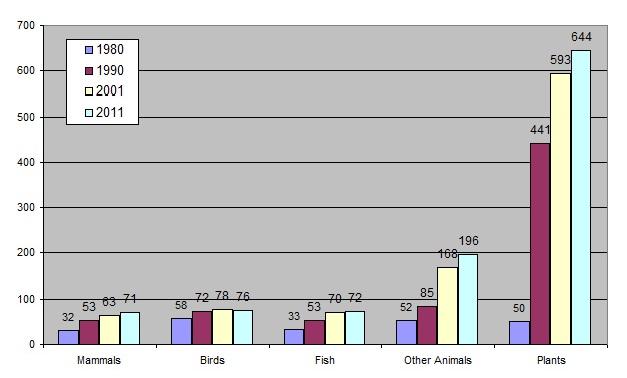
Map of World Endangered Species
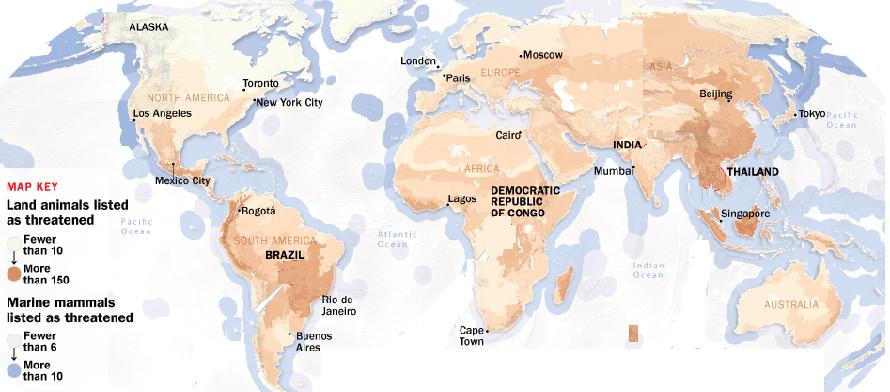
Global Fish Catch 1950-2009

Comparison of Catch and Aquaculture Production 2004-2009

Signatories to the Convention on Biodiversity

|
|
Waste Issues
What improvements have been made in waste management?
The environmental awareness of the past three decades has prompted far better management of solid and liquid wastes.
The Resource Conservation and Recovery Act was enacted by Congress in 1976. RCRA's primary goals are to protect human health and the environment from the potential hazards of waste disposal, to conserve energy and natural resources, to reduce the amount of waste generated, and to ensure that wastes are managed in an environmentally sound manner. Handlers of hazardous waste must meet certain regulatory requirements. Generators and transporters must have government issued identification numbers, and comply with other regulations regarding the handling of hazardous waste. Treatment, storage and disposal facilities must meet even more stringent requirements, and must have a permit to operate. Landfills that collect household garbage are predominately regulated by State and local governments. EPA has, however, established minimum criteria that these landfills must meet in order to stay open. The only hazardous waste that municipal landfills can accept is household hazardous waste and waste that is exempt from hazardous waste regulation. State and local governments are responsible for implementing these provisions. Hazardous wastes that are generated in the home are not regulated by the federal RCRA program although many communities regulate their disposal.
The amount of solid waste generated per person increased significantly from 1960 through 1990 but has been constant since at a rate of slightly more than 4.5 pounds per person, per day.  About 30% of the waste constitutes paper materials; the remainder comes from a variety of sources. About 30% of the waste constitutes paper materials; the remainder comes from a variety of sources.  A major development in waste management has been the emergence of recycling which has received wide public participation. Presently over twenty percent of all waste is recycled, a significant increase from 1960. A major development in waste management has been the emergence of recycling which has received wide public participation. Presently over twenty percent of all waste is recycled, a significant increase from 1960.  The recycling rate varies among common household materials. The recycling rate varies among common household materials.  The recycling trend has thus significantly reduced the overall increase in waste deposits. The recycling trend has thus significantly reduced the overall increase in waste deposits. 
But what about past disposals? What is the "Superfund"?
The discoveries of hazardous waste exposure and high incidence of health effects at the Love Canal, near Niagara Falls, prompted the 1978 enactment of the Resource Conservation and Recovery Act (RCRA) also known as the "Superfund".
This legislation requires the Environmental Protection Agency (EPA) to monitor cleanups at sites which release hazardous substances into the environment. EPA is authorized to direct responsible parties to eliminate the threats posed to the environment and public health and "clean up" the site. In the event that responsible parties do not fulfill their obligation, EPA is expected to direct and finance the cleanup with Superfund dollars and responsible parties must then reimburse Superfund. Since the enactment of this legislation, the EPA has identified about 39,000 cleanup sites nationally  and progress toward cleanup has been slow but steady. Until recently the Superfund had a surplus and the cost of cleanup was largely paid through industry reimbursements to the Superfund. But Congress has not extended the "polluter pays" funding concept and now taxpayers are funding most of the cleanup
and progress toward cleanup has been slow but steady. Until recently the Superfund had a surplus and the cost of cleanup was largely paid through industry reimbursements to the Superfund. But Congress has not extended the "polluter pays" funding concept and now taxpayers are funding most of the cleanup  and therehas been a resultant reduction in overall funding. and therehas been a resultant reduction in overall funding.  As a result, the rate of cleanup progress has significantly slowed. As a result, the rate of cleanup progress has significantly slowed. 
Under the prior Superfund legislation, the generators of the hazardous substances, the transporters who selected the site, and the owners and operators (both past and present) of the facility or property where the substance was released were considered liable. Liability is strict, joint and several, and retroactive, and defenses allowed by the act are few. Because of the high cost of cleanup, the legislation contributed to costly litigation between businesses concerning their share of such liability. These controversies concerning these problems have contributed to the reluctance of Congress to renew the prior Superfund financing scheme. The shift of responsiblity to the taxpayers for cleanup has dismayed environmental groups. They note that the "polluter pays" concept is not only fair but also operates as a powerful disencentive for industries to engage in future acts of pollution.
Does the Superfund address gasoline storage leaks?
No. Congress had specifically excluded petroleum products (although not petrochemicals) from the Superfund law. But legislation passed in 1986 established a separate trust fund program for this problem. The money in the fund is derived primarily from a 0.1 cent-per-gallon federal tax on motor fuels and several other petroleum products. The legislation directed EPA to establish financial responsibility requirements for owners and operators to cover costs of taking corrective action and to compensate third parties for injury and property damage caused by leaking tanks. The regulations require insurance coverage of $1 million, or alternatively, owners and operators may rely on state assurance funds to demonstrate financial responsibility.
What are brownfields? What are they? What issues concern these sites?
In 1993 the U.S. Environmental Protection Agency (EPA) began to address sites that may be contaminated by hazardous substances but which did not pose a serious enough public health risk to warrant cleanup under the Superfund program. Brownfields are abandoned, idled, or under-used industrial and commercial facilities where expansion or redevelopment is complicated by real or perceived environmental contamination. They range in size from a corner gas station to abandoned factories and mill sites. Estimates of the number of sites range from the tens of thousands to as high as 450,000 and they are often in economically distressed areas. Brownfield sites face a paradox: they are generally not eligible for remediation funding under the Superfund program because they pose a low public health risk while, at the same time, developers may avoid them because of cleanup costs, potential liability, or related reasons, thereby stalling economic development.
On April 21 2001, the Senate unanimously approved a bill which would authorize $1.25 billion over the next five years to help state and local governments clean up and redevelop more than 450,000 brownfields throughout the country. The measure would also encourage the redevelopment of brownfields by grantingp a liability exemption to prospective purchasers who do not cause or worsen the contamination at a site. The legislation precludes the EPA from interfering in the state cleanups unless (1) a state requests assistance, (2) the contamination migrates across state lines or onto federal property, or (3) there is an "imminent and substantial endangerment" to public health or the environment and additional work needs to be done.
How does the U.S. compare to other countries in waste generation?
The U.S. is no longer the international leader in waste generation per capita but U.S. waste generation is still well in excess of the average for developed countries. 
Where do Democrats and Republicans stand on waste issues?
Both parties support efforts to proper manage and clean-up wastes. Republicans tend to support measures to transfer responsibility for these processes from the EPA to state and local governments. They also tend to object to stringent liability requirements on businesses and landowners for the cost of clean-up. Republicans for the most part oppose the special taxes on polluters to finance the Superfund. 
Waste Links
Google Directory - Hazardous_Materials
Waste management - Wikipedia, the free encyclopedia
Superfund - Wikipedia, the free encyclopedia
How Stuff Works - Landfills
EPA Cleanup Page
EPA Page on Wastes
EPA Superfund Page
|
Charts
(click to enlarge)
Return to Top
Municipal Waste Generation 1960-2009
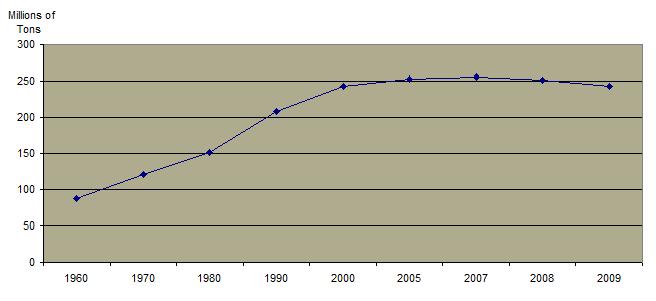
Sources of Municipal Waste
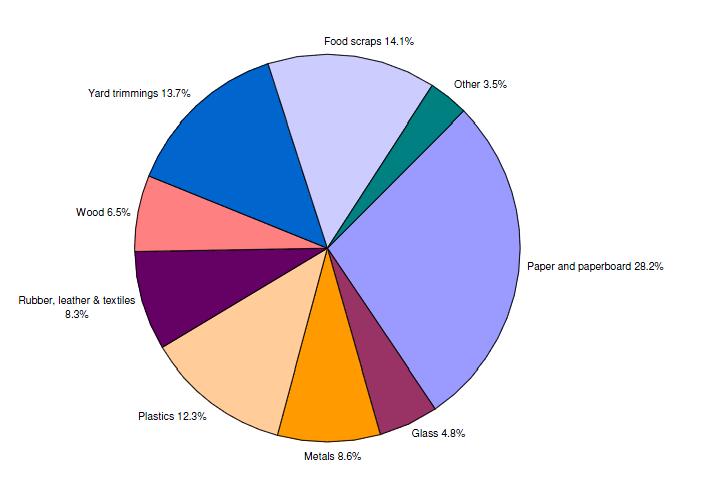
Percentage of Waste Recovered 1960-2009
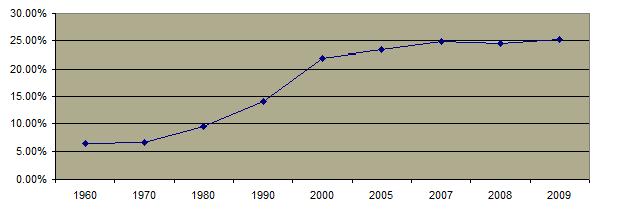
Recycling Rate for Major Waste Items
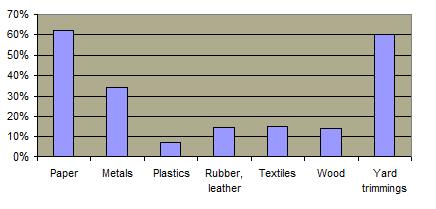
Total and Net Waste Generation 1960-2009
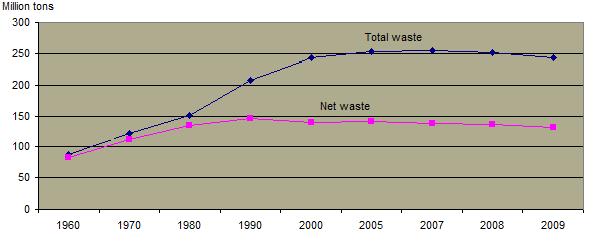
Status of Superfund Sites 2010
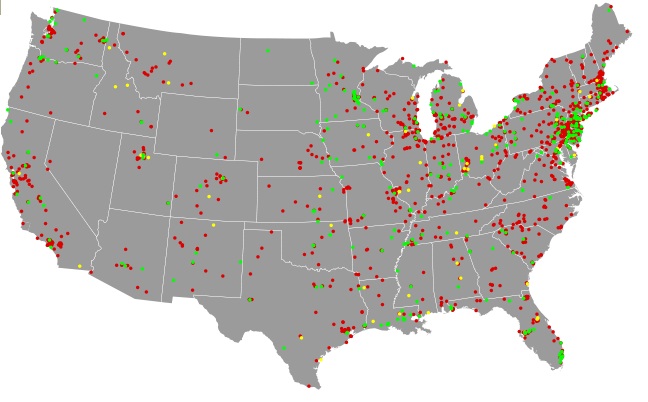
Source of Funding for Cleanup of Superfund Sites 1981- 2007
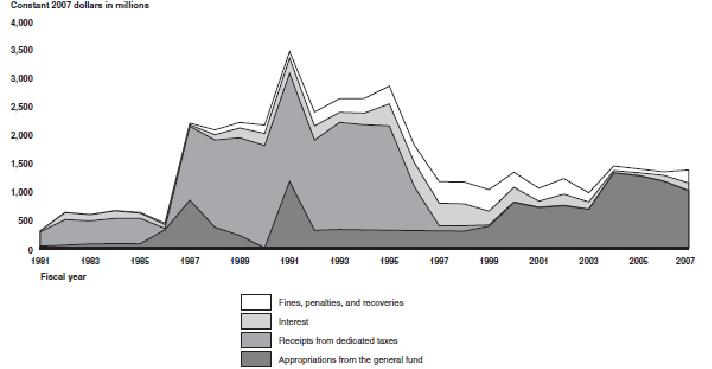
Fundiing For Superfund Cleanup 1981-2007
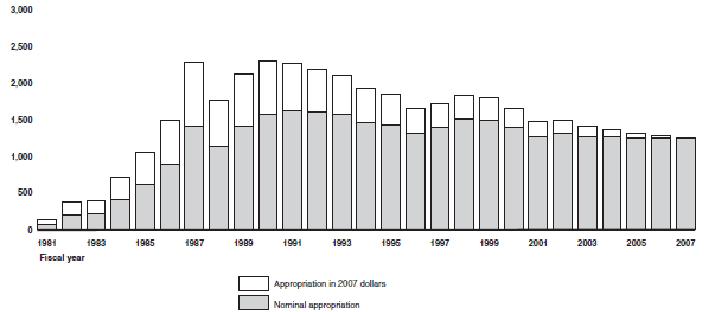
Completed Supefund Projects 1982-2010
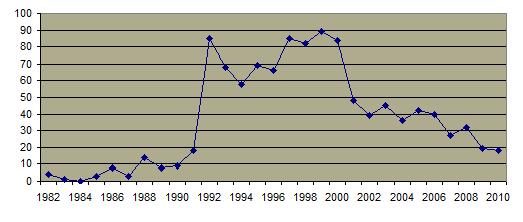
Waste Generation Per Capita in Developed Countries
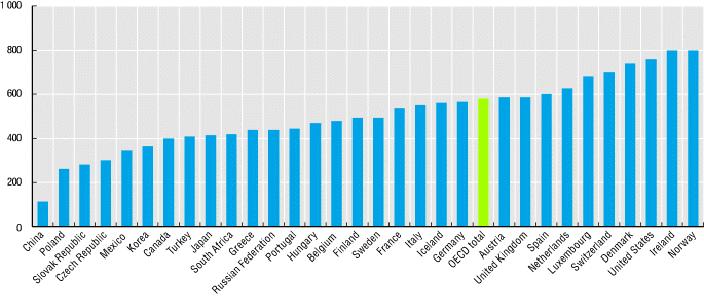
Extension of Superfund "Polluter Pay" Funding
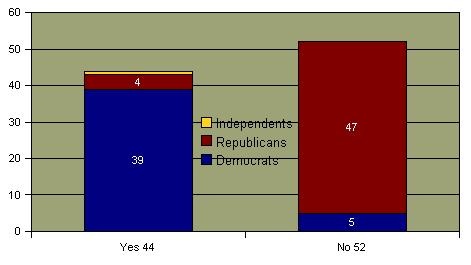
|
|
Nuclear Power Concerns
Do the environmental dangers associated with nuclear power justify its use?
This is a difficult question. At one time nuclear power was considered a very attractive alternative to the use of fossil fuels. Although the construction cost in creating such facilities are extensive, the plants can be cost effective because they do not rely on large quantities of expensive fuels. Nuclear power also has the advantage of significantly reducing greenhouse emissions. But concerns about the safety of nuclear power have again increased after a severe earthquake and tsunami struck northern Japan in March 2011. Damage caused by the tsunami interfered with the plant operations, causing a meltdown of three reactors, and there was a significant dangerous leakage of radiation, prompting evacuations in the area. In the wake of this disaster, there has been a significant international concern regarding the safety of nuclear power.
In the United States, nuclear power assumed an increasing amount of U.S. electricity production in the 1970's and 1980's  but its development began to stall in the wake of the Three Mile Island incident in 1979. Still nuclear power is a major source of electricity transmission in the U.S., particularly in many southern and eastern seaboard states. but its development began to stall in the wake of the Three Mile Island incident in 1979. Still nuclear power is a major source of electricity transmission in the U.S., particularly in many southern and eastern seaboard states.  Globally, nuclear power is an important source of electricity generation in many countries and there has been a steady increase in the reliance on nuclear power. About 16% of the world's electricity is now produced by nuclear power and some countries rely on nuclear power for most of their electricity generation. Globally, nuclear power is an important source of electricity generation in many countries and there has been a steady increase in the reliance on nuclear power. About 16% of the world's electricity is now produced by nuclear power and some countries rely on nuclear power for most of their electricity generation.  Before the Japanese disaster, U.S. public opinion had begun to shift regarding the desirability of constructing new nuclear power plants, but in the wake of the Japanese disaster, it has returned to prior levels. Before the Japanese disaster, U.S. public opinion had begun to shift regarding the desirability of constructing new nuclear power plants, but in the wake of the Japanese disaster, it has returned to prior levels. 
There are three major problems with nuclear power:
- The ongoing possibility of an operational accident which could ultimately be catastrophic.
In addition to the Japanese incident, two other major nuclear power accidents have helped dampen the enthusiasm for nuclear power. In 1979, at Three Mile Island in Pennsylvania, there was a partial core meltdown due to a faulty valve and the failure of the instrumentation to properly inform the operators regarding the nature of the problem. Although there were no identifiable injuries from the accident, the incident was a public relations disaster for the nuclear power industry. A far more serious accident occurred in the Chernobyl, Ukraine, in 1986. This accident was due to faulty reactor design and also faulty instrumentation which prevented the operators from quickly correcting the problem. It produced a plume of radioactive debris that drifted over parts of the western Soviet Union, Eastern Europe, and Scandinavia. Large areas of Ukraine, Belarus, and Russia were contaminated, resulting in the evacuation and resettlement of roughly 200,000 people. About 60% of radioactive fallout landed in Belarus. The overall health consequences of the incident are not completely clear. Most of those affected received relatively low doses of radiation; there is little evidence of increased mortality, cancers or birth defects among them; and when such evidence is present, existence of a causal link to radioactive contamination is uncertain. The abandoned reactor site itself is a source of current concern because about 95% of the fuel remains inside. Efforts to permanently enclose it to prevent further decontamination have been unsuccessful. The problem has been more economic and political than technological. Among the former Soviet countries, the Ukraine's adjustment to a market economy and autonomy has been particularly difficult.
Proponents of nuclear power argue that the overall operational safety record of the nuclear power industry has been good and that improved plant design, automation, and operator training will effectively prevent future accidents. Opponents maintain that such safety can never be assured.
- The possibility of a catastrophic terrorist attack on a nuclear power facility.
Opponents of nuclear power express concerns that nuclear waste is not well protected, and that it can be released in the event of terrorist attack. Proponents of nuclear power contend, however, that nuclear waste is well protected, and state their argument that there has been no accident involving any form of nuclear waste from a civilian program worldwide. In addition, they point to large studies which tested the robustness of both reactor and waste fuel storage, and found that they should be able to sustain a terrorist attack comparable to the September 11. Perhaps the most significant concern involves a terrorist takeover of a nuclear facility. If a terrorist had the technical ability to operate the controls, a catastrophic event could be set in motion.
- The long term storage of nuclear waste.
The problems associated with nuclear waste have been very difficult. Unfortunately, there has been little progress in identifying acceptable solutions for the storage of this waste. A legislative mandate to obtain a storage location by 1998 was not met and nuclear utilities have successfully sued to hold the Department of Energy liable for the costs of future storage of utility-generated waste.
The main concern involves the storage of high level nuclear waste from weapons manufacturing and spent fuel from commercial reactors operated by utilities. There has been tremendous difficulty in identifying a site for permanent storage for this waste. The problem is confounded by concerns associated with transportation of these materials. Much of the inventory of high level waste is presently stored at three federal sites operated by the Department of Energy in South Carolina, Washington and Idaho.
The safety of geologic disposal of highly radioactive waste, as planned in the United States, depends largely on the characteristics of the rock formations from which a repository would be excavated. Because many geologic formations are believed to have remained undisturbed for millions of years, it appears technically feasible to isolate radioactive materials from the environment until they decayed to safe levels. But much of the problem results from the inherent uncertainty involved in predicting waste site performance for the 10,000-year period (or longer) that nuclear waste is to be isolated. Opponents of geologic disposal have urged greater emphasis on new or alternative technologies that might allow entirely different approaches to high-level radioactive waste management.
The primary site selected for storage is the Yucca Mountain site in Nevada. The state of Nevada has fought DOE's efforts to move nuclear waste to this site based on safety issues. Legislation to use Yucca Mountain as an initial temporary site for commercial waste was vetoed by the Clinton Administration and the Senate fell three votes short of overriding the veto.  The Clinton Administration's position was that nuclear waste should not be stored temporarily near Yucca Mountain before the site had been found suitable for permanent underground disposal. This generally has been the view of most environmental organizations. The Bush Administration supports the use of the Yucca Mountain site. In 2002, Congress voted to approve the site The Clinton Administration's position was that nuclear waste should not be stored temporarily near Yucca Mountain before the site had been found suitable for permanent underground disposal. This generally has been the view of most environmental organizations. The Bush Administration supports the use of the Yucca Mountain site. In 2002, Congress voted to approve the site  . However, the Obama Administration has called for a new review of disposal options and the entire project has been suspended. Several European countries have active programs dedicated to safe permanent storage of the waste but there is no international agreement at present regarding the most appropriate method. . However, the Obama Administration has called for a new review of disposal options and the entire project has been suspended. Several European countries have active programs dedicated to safe permanent storage of the waste but there is no international agreement at present regarding the most appropriate method.
Nuclear Waste Links
Google Directory - Nuclear Waste
How Stuff Works - Nuclear Power
Nuclear power - Wikipedia, the free encyclopedia
Radioactive waste - Wikipedia, the free encyclopedia
Yucca Mountain nuclear waste repository - Wikipedia
Department of Energy - Nuclear
Return to Top
|
Charts
(click to enlarge)
Share of Nuclear Generated Electricity in US

Nuclear Percentage of Electricity Generation By State

Percentage of Nuclear Electricity Generation in Nuclear Countries
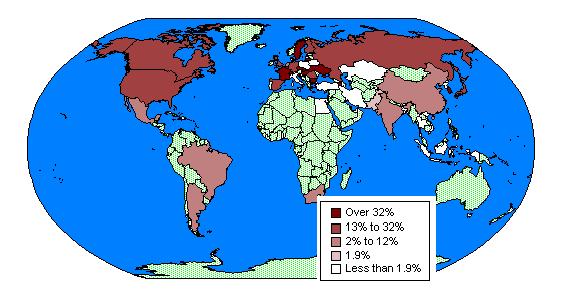
Public Opinion on Construction of New Nuclear Power Plants

Senate Vote to Override Yucca Veto

Vote to Approve Yucca Mountain
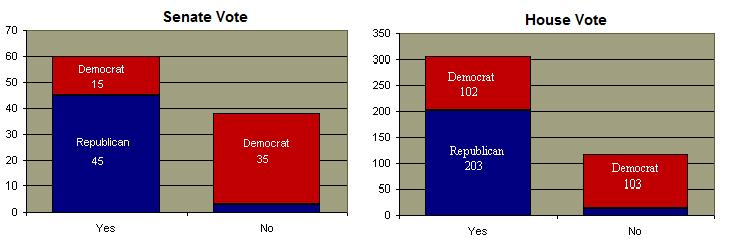
|
|
Water Quality
What has been done about waste discharges into our waterways and oceans?
Since passage of the Clean Water Act in 1972, most of the conspicuous water pollution of the later 1960s and 1970s has been eliminated.
A major feature of this legislation authorized federal financial assistance of municipal sewage treatment plant construction and set standards for proper secondary treatment of this waste water. By 1988, 86% of all cities met the 1988 deadline. The remainder were put under judicial or administrative schedules requiring compliance as soon as possible. However, many cities, especially smaller ones, continue to make investments in building or upgrading facilities needed to achieve secondary treatment.
Although sewage treatment has eliminated a major source of water pollution, progress in dealing with industrial polluters appears to be unsuccessful in many areas. The Clean Water Act also requires industrial and municipal dischargers to obtain permits. Sources are required to maintain records and to carry out regular monitoring activities. Permits are issued for 5-year periods and must be renewed thereafter to allow continued discharge. The success of this permit system has not been uniform. Many states have not regularly renewed permits on a timely basis.  (Click to see map) The result is that multiple violations are quietly tolerated in many states (Click to see map) The result is that multiple violations are quietly tolerated in many states  at very high levels of pollution. at very high levels of pollution. 
The result is that significant water pollution is still a problem. Under the Bush Administration, the EPA discontinued making annual reports to Congress. But the last report issued in 2002 indicated that many U.S. rivers, lakes, and estuaries are still too polluted for safe fishing or swimming.  The number of beach closings has significantly increased during the past decade. The number of beach closings has significantly increased during the past decade. 
Return to Top
Clean Water Links
Google Directory - Water Resources
WIkipedia - Clean Water Act
WIkipedia - Clean Water Action
Green Wikia - Clean Water Campaign
Clean Water Action
EPA - Hudson River PCBs
|
Charts
(click to enlarge)
Percentages of Expired Water Permits By State

Percentage of Facilities Violating Clean Water Act by State
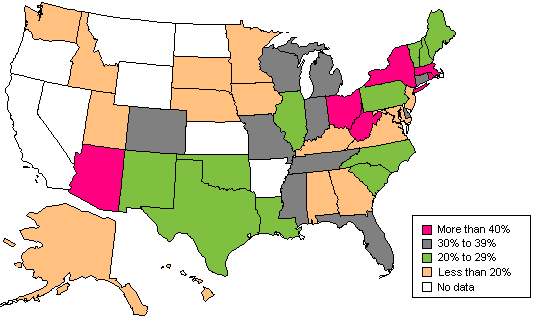
Magnitude of Average Water Pollution Violation by State
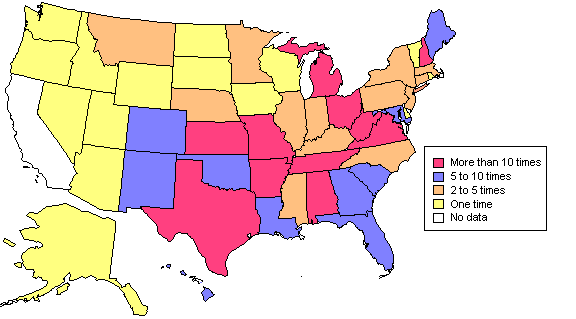
Status of Monitored Lakes, Rivers and Estuaries 2002

Causes and Numbers of Beach Closings 2000-2008
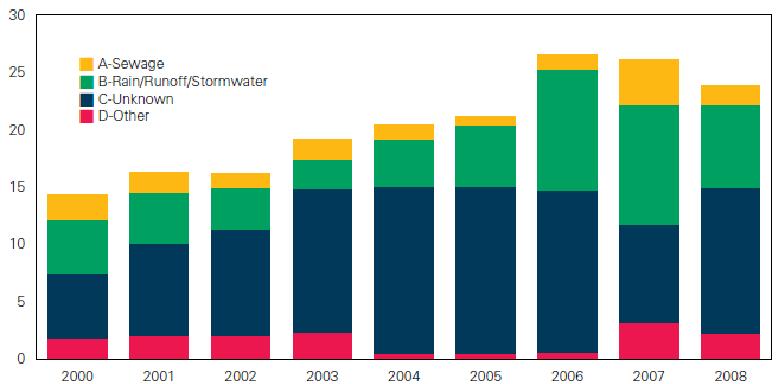
|
|
Chemicals in Air and Food
What have we done to protect ourselves from chemicals in the air and food chain?
Rachel Carson's Silent Spring, published in 1962, focused worldwide attention on the potential for dichlorodiphenyl trichloroethane (DDT), polychlorinated biphenyls (PCBs) and other contaminants to persist in the environment and harm fish and wildlife. The United States responded by establishing programs to control these chemicals. Over the last several decades, the use of some persistent contaminants such as DDT and PCBs was greatly curtailed, and concentrations in fish and wildlife significantly declined.  (Click to see chart) Although overall concentrations have declined, residues of these contaminants remain widespread, and fish consumption advisories remain in effect for some waters. (Click to see chart) Although overall concentrations have declined, residues of these contaminants remain widespread, and fish consumption advisories remain in effect for some waters.
The Pesticide Act directs EPA to restrict the use of pesticides as necessary to prevent unreasonable adverse effects on people and the environment, taking into account the costs and benefits of various pesticide uses. FIFRA prohibits sale of any pesticide in the United States unless it is registered and labeled indicating approved uses and restrictions. It is a violation of the law to use a pesticide in a manner that is inconsistent with the label instructions.
The Pollution Prevention Act requires owners and operators of manufacturing facilities to report annually on source reduction activities. Based on data collected by the EPA, releases have remained substantial  , particularly in the mining states of Alaska and Nevada. , particularly in the mining states of Alaska and Nevada.  (Click to see map) (Click to see map)
Why are many environmentalists still concerned about chemicals in our air and foods?
Mainly because we have a better understanding of the possible relationships between chemical exposure and health. Not long ago, scientists considered cancer to be the main threat from exposure to toxic chemicals. Now new research suggests that immune disorders and associated maladies are an important outcome to chemical exposure. The risk is especially great for infants and small children whose immune systems are not fully developed. As a result, environmentalists argue that the current standards of safety for problem chemicals are too high. Moreover, because these chemicals are in widespread use in many countries which have not banned them and because they can become airborne and travel long distances, there is the need for international action. As urban development continues and becomes adjacent to agricultural land, the concern has increased. The increasing incidence of West Nile Virus, a mosquito bourne illness, has also prompted increased use of dangerous pesticides to control this problem, adding to the environmental concerns.
Pesticide residues also continue to be very common in food products. In FDA tests, residues were found in a substantial percentage of food samples although most were within what the FDA regards as acceptable limits. The majority of the samples that were violative of standards were from imported foods.  The FDA findings show little change in these percentages in recent years. The FDA findings show little change in these percentages in recent years. 
Some recent studies strongly support the link between pesticsides and disease. In the Canadian Arctic, Quebec community health have identified a relationship between unusually high rates of infectious disease and lowered intelligence among Inuit children who have been exposed to toxic chemicals through the air and through the food chain. A study from Holland published in the journal Pediatric Research found a correlation between PCB/dioxin exposures and suppressed levels of disease-fighting white blood cells in young children.
There has been a puzzling increase in certain diseases and conditions which many researchers believe are related to some type of immune dysfunction. The number of children requiring treatment for asthma has increased dramatically.  Women are beginning to develop sexual characteristics at an earlier age. There has been a puzzling decrease in male sperm count and a rise in the rate of testicular cancer. There has been a surge in identified cases of autism Women are beginning to develop sexual characteristics at an earlier age. There has been a puzzling decrease in male sperm count and a rise in the rate of testicular cancer. There has been a surge in identified cases of autism  , attention deficit disorder (ADD), and attention deficit hyperactivity disorder (ADHD). Finally there are certain conditions that are entirely new and which are just now becoming generally accepted as genuine conditions by the medical community: chronic fatigue syndrome and multiple chemical sensitivity (MCS). , attention deficit disorder (ADD), and attention deficit hyperactivity disorder (ADHD). Finally there are certain conditions that are entirely new and which are just now becoming generally accepted as genuine conditions by the medical community: chronic fatigue syndrome and multiple chemical sensitivity (MCS).
The chemicals of concern are called Persistent Organic Pollutants (POPs) by concerned environmental experts. They include PCBs, DDT and 10 other chemicals. All 12 POPs resist the normal processes of degradation and have also been recently identified as "endocrine disruptors"; chemicals that can interfere with the body's own hormones even at low doses. POPs are highly stable compounds that can accumulate and remain in the environment or in body tissue for years or decades before breaking down. Persistent contaminants are now pervasive in the food web, with animal products (meat, fish, and milk), as the primary routes of human exposure. Although human health is of paramount concern these chemicals are even more toxic to plant and animal life. The chemicals are suspected in recent observations of aberrant animal behavior and the "die off" of certain marine mammals.
What is being proposed to further address this problem?
Environmental reform organizations believe that the problem needs to be addressed through a binding international treaty. Although some international conventions exist with respect to waste discharges, there is no present agreement that directly addresses POP contamination. Most countries now subscribe to the Basil Convention on the Control of Transboundary Movements of HazardousWastes and their Disposal. 
After three years of negotiations, a United Nations treaty was negotiated in December 2000. Known as the Stockholm Convention on Persistent Organic Pollutants, it has been adopted by most countries with the notable exceptions of the United States and Russia.  The treaty calls on all parties to take the legal and administrative measures necessary to eliminate the production and use of all POP except DDT and PCBs. The continued use of DDT and PCBs is allowed but restricted, subject to country-specific provisions, and with the goal of ultimate elimination. DDT, for instance, is to be used in the interim only for disease vector control in accordance with World Health Organization guidelines, in particular for malaria control, and the treaty calls for research, development, and implementation of safe, effective, and affordable alternatives to DDT. The treaty calls on all parties to take the legal and administrative measures necessary to eliminate the production and use of all POP except DDT and PCBs. The continued use of DDT and PCBs is allowed but restricted, subject to country-specific provisions, and with the goal of ultimate elimination. DDT, for instance, is to be used in the interim only for disease vector control in accordance with World Health Organization guidelines, in particular for malaria control, and the treaty calls for research, development, and implementation of safe, effective, and affordable alternatives to DDT.
Return to Top
Chemical Links
Google Directory - Ecotoxicology
EPA Pollutants/Toxics Page
EPA Site on Pesticides and Food
Pesticide Action Network
Consumers Union Food Safety Program
|
Charts
(click to enlarge)
Contaminant Levels in Lake Erie Eggs 1974-2004

Environmental Releases, Transfers, and Production-Related Waste

Toxic Waste By State
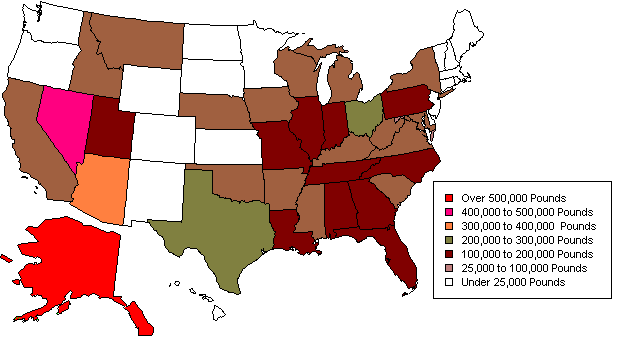
Pesticide Residues in Sample Grains, Vegetables and Fruits 2006
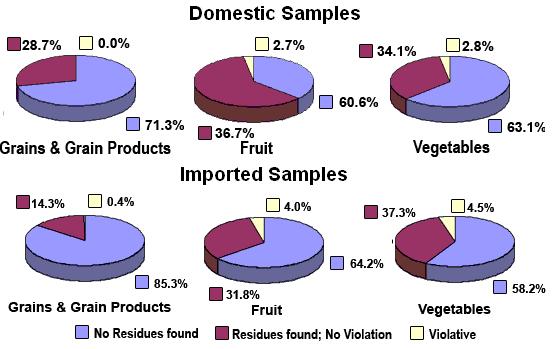
Trend in Pesticide Residues Found in Domestic Samples

Incidence of Asthma in Children
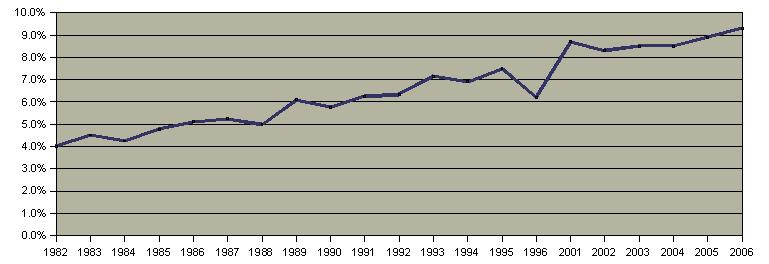
Increase in Autism 1992-2007

Signatories to Basil Agreement
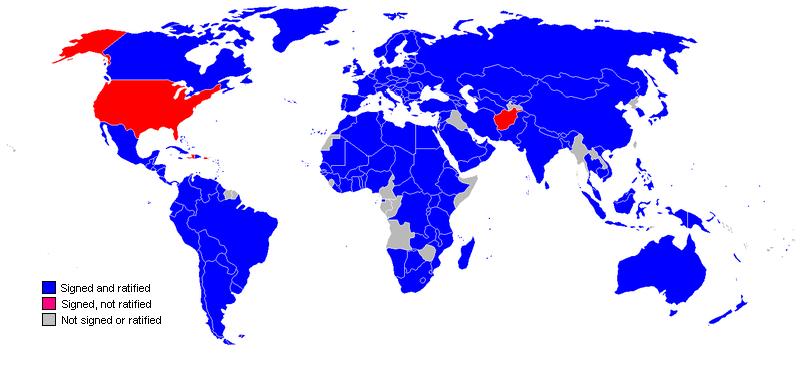
Signatories to the Stockholm Convention on POPs

|
|
Genetically Modified Foods
What is the conern about genetically altered foods? Has the government determined them to be safe?
Yes, the FDA has determined these foods to be safe because they are "substantially similar" to the foods that they are replacing. But the possible health affects have not been fully studied.
A quiet revolution has engulfed the agricultural industry during the past decade. Advances in biochemical science have resulted in the immediate introduction of food varieties that are "genetically engineered". By modifying DNA characteristics, scientists have successfully incorporated into plants both input traits designed for the convenience of growers, processors and marketers and output traits aimed at providing direct nutritional and food quality benefits to consumers. Input traits include pest and disease resistance, herbicide resistance, and other techniques designed to increase crop yield. Because of more predictable yields, these products have quickly gained acceptance among American growers. Over 80% of American soybeans and nearly 50% of American corn is presently based on genetically engineered products.  Globally, the percentage of acreage devoted to these crops continues to climb. Globally, the percentage of acreage devoted to these crops continues to climb. 
Some environmentalists argue that the dangers posed by GM foods involve the possibility that the food will produce a protein that is toxic or allergenic to some or all human beings, the nature and potency of that protein's toxicity or allergenicity, and the magnitude of dietary exposure to that protein. Genetic modifications designed to enhance input or output traits might incorporate proteins that induce allergenic responses in some sensitive people. Supporters of genetically modified crops respond that there are actually some current health benefits from these products and more can be developed. In addition, they note that 81 scientific studies financed by the European Commission have all shown no evidence of risk to human
and animal health or to the environment from genetically modified crops.
Despite these studies, the European Union has not been receptive to the introduction of these foods. Labeling requirements requiring identification of all GM food products has effectively prevented European agricultural interests from using this technology. Almost 80% of acreage devoted to these foods is presently located in two countries: the U.S. and Argentina.  The European resistance to these foods has had trade reprecussions and has contributed to the present international tension between Europe and the United States. Unlike Europe, public opinion supports the technology in the U.S. The European resistance to these foods has had trade reprecussions and has contributed to the present international tension between Europe and the United States. Unlike Europe, public opinion supports the technology in the U.S.  although much of the public lacks information on the subject. although much of the public lacks information on the subject. 
Where do Democrats and Republicans stand on genetic foods?
Nationally, the issue does not generate much partisan debate. The 2004 Democratic platform was silent on the issue while, without specifically referring to genetically modified foods, the Republican platform lamented the "outrageous" trade restrictions imposed by Europe on American crops and livestock. A 2002 ballot initiative in Oregon to require labeling of genetically engineered food got less than 30 percent of the vote. Bills to require labeling of genetically modified foods have failed in California, Maine, Michigan and Vermont in recent years.
Return to Top
Genetically Modified Food Links
Google Directory - Genetically Modified Food
Genetically modified food - Wikipedia, the free encyclopedia
How Stuff Works - Genetically Modified Foods
BBC: Questions and Answers on Genetically Modified Foods
|
Charts
(click to enlarge)
U.S. Trends in Genetically Engineered Crops
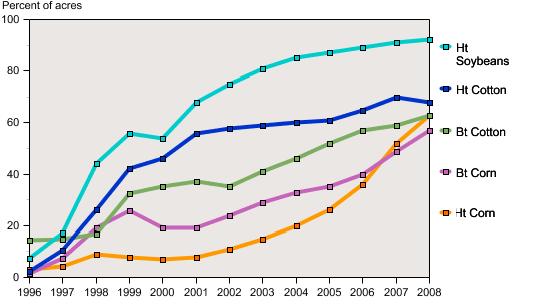
Percentage of Arable Land Used For GM Crops in 2007
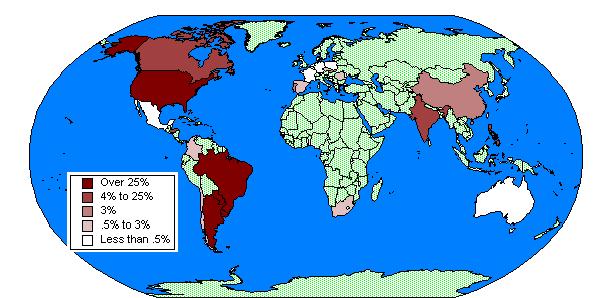
Distribution of Global Acreage Devoted to GM Crops
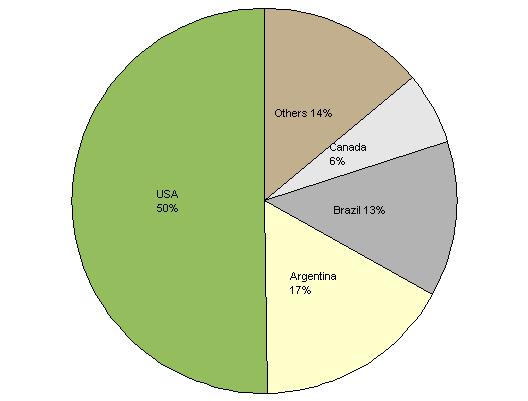
US Public Opinion on GM Foods
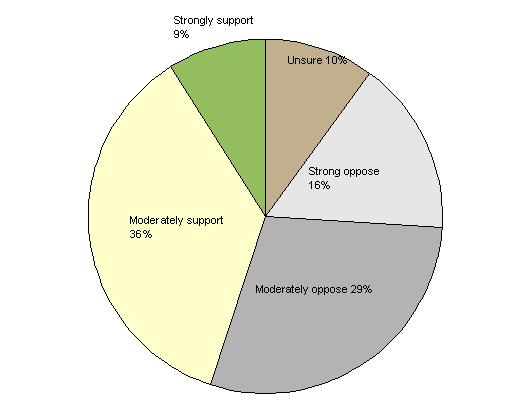
US Awareness of GM Crop Controversy
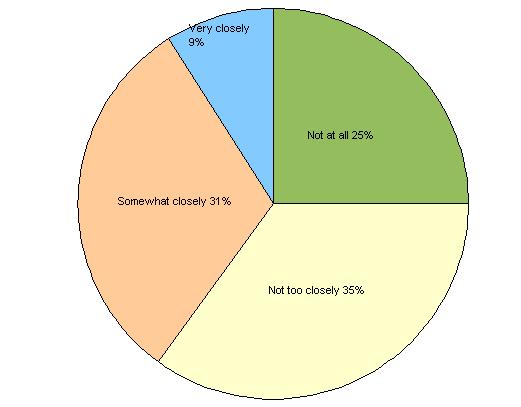
|
|
Global Population Growth
How are population trends affecting the global environment?
The world's population has increased dramatically in the past century.  The growth has been primarily related to dramatic increases in life expectancy The growth has been primarily related to dramatic increases in life expectancy  and reduced infant mortality and reduced infant mortality  . But the evidence clearly suggests that as societies become more modern and experience human development, a "fertility transition" occurs. In highly developed societies, people choose to limit family size to about two children. In low developed societies, people tend to produce large families. In 1990, 50% of the world's population were living in low developed societies and the birth rate was high. By 2005, only 5% of the world's population were living in such societies. . But the evidence clearly suggests that as societies become more modern and experience human development, a "fertility transition" occurs. In highly developed societies, people choose to limit family size to about two children. In low developed societies, people tend to produce large families. In 1990, 50% of the world's population were living in low developed societies and the birth rate was high. By 2005, only 5% of the world's population were living in such societies. In many countries, there is even concern that a low fertility rate coupled with an aging population will severely curtail economic growth. In many countries, there is even concern that a low fertility rate coupled with an aging population will severely curtail economic growth.
The environmental consequences of maintaining the world's high population level are significant.
In terms of providing the basic necessities of life, the evidence suggests that the present high level of global human population is sustainable. So far, world agricultural output has outpaced the world's population increase  even though many of the world's agricultural regions remain poorly developed. Although the global water supplies are being severely challenged in some regions, better water management and delivery can effectively address this problem. even though many of the world's agricultural regions remain poorly developed. Although the global water supplies are being severely challenged in some regions, better water management and delivery can effectively address this problem.
The major potential environmental impact of present and future high global population levels is associated with the consequences of poorly regulated economic development. Carbon dioxide emissions are disporportionately high in countries with advanced economies. The destruction of global rain forests is related to both population pressures and poorly regulated economic motivations. Although some believe that an environmental catastrophe is inevitable unless there is an immediate drastic reduction in world population levels, others believe that the environmental damage caused by high population/developed economy societies can be repaired and controlled if there is sufficient international political will to address the problem.
General Environment Links
Google Directory - Environment
Natural environment - Wikipedia, the free encyclopedia
About.com: Environment
Environmental Organization Web Directory
EnviroLink
Almanac of Policy Issues
United Nations Environment Program
European Environmental Agency
Environmental Defense
Friends of the Earth
Greenpeace USA
Natural Resources Defense
Council (NRDC)
Nature Conservancy
Sierra Club
World Resources Institute
World Wildlife Fund
(U.S)
CATO
Institute: Natural Resources and Environmental Studies
Population Links
Google Directory - Population
Wikipedia
- Population
Population Reference Bureau
Population
Connection (formerly Zero Population Growth)
Population
Growth from About.com
|
Charts
(click to enlarge)
Population Growth Trend
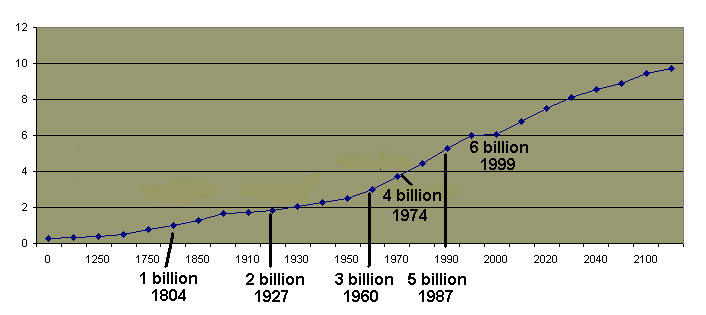
Changes in Global Life Expectancy 1900-2000
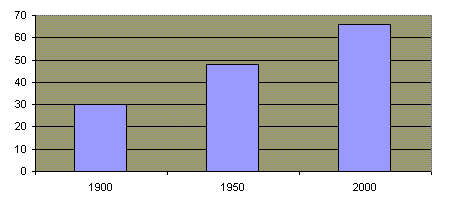
Global Infant Mortality Per 1000 Births 1950 and 2000
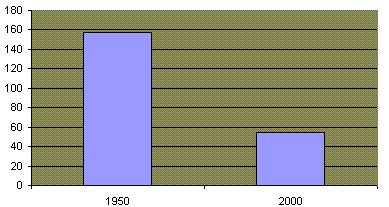
Changes in Population, Human Development and Birth Rate 1990 and 2005
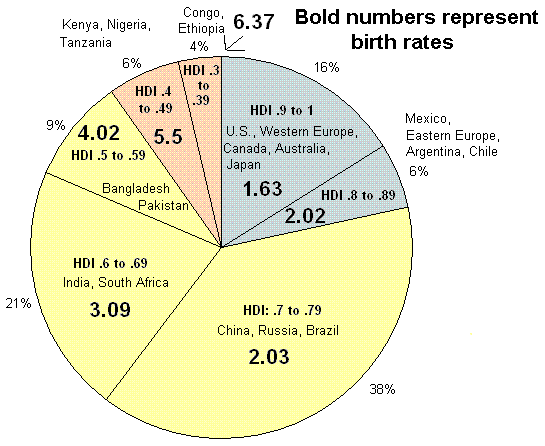
Trends in Agricultural Production and Population
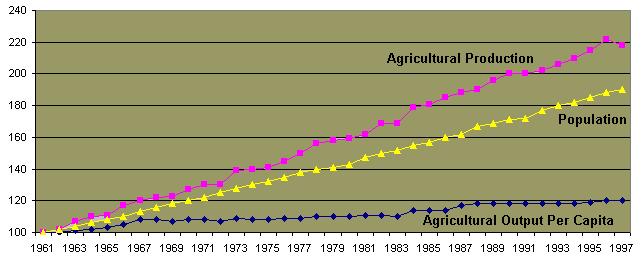
|
|

